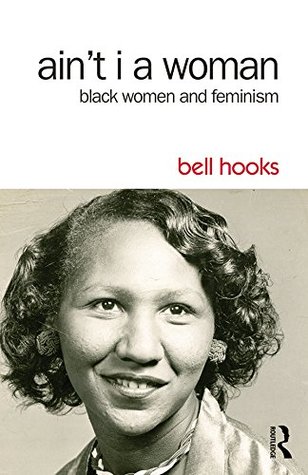More on this book
Community
Kindle Notes & Highlights
Throughout American history, the racial imperialism of whites has supported the custom of scholars using the term “women” even if they are referring...
This highlight has been truncated due to consecutive passage length restrictions.
The most glaring example of their support of the exclusion of black women was revealed when they drew analogies between “women”
and “blacks” when what they were really comparing was the social status of white women with that of black people.
“woman” is synonymous with “white women” and the term “blacks” synonymous with “black men.”
exists in the language of the very movement that is supposedly concerned with eliminating sexist oppression, a sexist-racist attitude toward black women.
All too frequently in the women’s movement it was assumed one could be free of sexist thinking by simply adopting the appropriate feminist rhetoric;
it was further assumed that identifying oneself as oppressed freed one from being an oppressor.
That black women did not collectively rally against the exclusion of our interests
by both groups was an indication that sexist-racist socialization had effectively brainwashed us to feel
that our interests were not worth fighting for, to believe that the only option available to us was subm...
This highlight has been truncated due to consecutive passage length restrictions.
The Black Woman edited by Toni Cade.
white women are given grant money to do research on black women
but I can find no instance where black women have received funds to research white women’s history.
Black women writers Alice Walker, Audre Lorde, Barbara Smith, and Cellestine Ware have been the most willing to place their writings in a feminist framework.
All too often in our society, it is assumed that one can know all there is to know about black people by merely hearing the life story and opinions of one black person.
We cannot form an accurate picture of woman’s status by simply calling attention to the role assigned females under patriarchy.
To both groups I voiced my conviction that the struggle to end racism and the struggle to end sexism were naturally
intertwined, that to make them separate was to deny a basic truth of our existence,
that race and sex are both immutable facets of...
This highlight has been truncated due to consecutive passage length restrictions.
Institutionalized sexism— that is, patriarchy—formed the base of the American social structure along with racial imperialism.
repress their awareness of themselves as free people and to adopt the slave identity imposed upon them.
Implicit in this assertion is the assumption that the worst that can
happen to a man is that he be made to assume the social status of woman.
In the eyes of colonial white Americans, only debased and degraded members of the female sex labored in the fields.
The popular notion that black slaves working in the white household were automatically the recipients
of preferential treatment is not always substantiated by the personal accounts of slaves.
House slaves were less subjected to the physical hardships that beset field...
This highlight has been truncated due to consecutive passage length restrictions.
more likely to suffer endless cruelty and torture because they were constantly in the presence of dem...
This highlight has been truncated due to consecutive passage length restrictions.
House slaves complained repeatedly about the stress and strain of being constantly under the surveillance of white owners.
While institutionalized sexism was a social system that
protected black male sexuality, it (socially) legitimized sexual exploitation of black females.
Linda Brent in the narrative of her slave experience
Slavery is terrible for men; but it is far more terrible for women. Superadded to the burden common to all, they have wrongs, and suffering, and mortifications peculiarly their own.
Black activist Angela Davis has convincingly argued that the rape of black female slaves was not, as other scholars have suggested, a
case of white men satisfying their sexual lust, but was in fact an
institutionalized method of terrorism which had as its goal the demoraliza...
This highlight has been truncated due to consecutive passage length restrictions.
of black ...
This highlight has been truncated due to consecutive passage length restrictions.
In 1839, the book A merican Slavery: As It Is was published anonymously by white abolitionists who
believed they could destroy the pro-slavery arguments by exposing in print the horrors of slave life.
desire to bring an end to sexual contact between white men and black female slaves.
They were not concerned about the plight of enslaved black women, but about saving the souls of white men whom they believed had sinned against God by their acts of moral depravity.
Many pro-slavery white women ultimately denounced slavery because of their outrage at the sex...
This highlight has been truncated due to consecutive passage length restrictions.
She felt that her marriage vows were desecrated, her dignity insulted; but she had no compassion for the poor victim of her husband’s perfidy.
Feeling remorse, anger, and resentment cannot be seen as synonymous with feeling de-masculinized.
As a farm laborer, the black male slave performed the same tasks he would have had to perform as a free person, but black
women were well aware that it was not deemed ladylike or respectable for women to work in the fields.
Devaluation of black womanhood after slavery ended was a conscious, deliberate effort on the
part of whites to sabotage mounting black female self-confidence and self-respect.
Black Women in White America, Gerda Lerner discusses the “complex system of supportive mecha...
This highlight has been truncated due to consecutive passage length restrictions.
Jim Crow or “separate but equal” years, but both phrases shift attention away from the fact that


